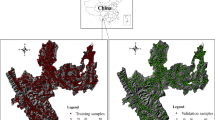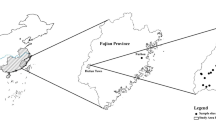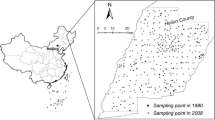Abstract
For the monitoring of soil fertility and health, soil samples are collected continuously every year in specific regions in China. The high-precision spatiotemporal (ST) continuous distribution of soil properties, e.g., soil organic matter (SOM), must be obtained based on ST soil samples. A total 11,716 soil samples were collected in Zigui County, Hubei Province, China in 2006–2018. First, the experimental variograms of SOM for various spatial and temporal lags were calculated. Second, a hybrid theoretical model integrating variations at the spatial and temporal scales was constructed to model the ST variations in SOM data. Third, the ST ordinary kriging (STOK) method was employed to determine the ST SOM distribution in the study area from 2006 to 2018. Then, the results obtained by STOK were compared with those generated by spatial ordinary kriging (OK) using the soil samples collected in one year. Finally, the temporal trend and change of SOM were analyzed based on the obtained ST distribution data. The results showed that (1) the STOK method performed better than the OK method because the STOK results attained a higher estimation accuracy and a more stable estimation variance in the years with a limited number of soil samples; (2) from 2006 to 2018, the SOM showed significant downward and significant upward trends in 15.05% and 32.05% of the total regional area, respectively. However, compared in 2006, the SOM in 2018 showed significant decreases and increases in 37.2% and 44.57% of the study area, respectively.







Similar content being viewed by others
Data availability
The datasets used and analyzed during the current study are available from the corresponding author on reasonable request.
References
Akita Y, Chen JC, Serre ML (2012) The moving-window Bayesian maximum entropy framework: estimation of PM2.5 yearly average concentration across the contiguous United States. J Expo Sci Env Epid 22:496–501
Christakos G (1992) Random field models in earth sciences. Academic, San Diego
Christakos G (2000) Modern spatiotemporal geostatistics. Oxford University Press, Oxford
Christakos G, Bogaert P (1996) Spatiotemporal analysis of springwater ion processes derived from measurements at the Dyle Basin in Belgium. IEEE T Geosci Remote 34:626–642
Christakos G, Hristopulos DT (1998) Spatiotemporal environmental health modelling. Kluwer Academic Publishing, Boston
Cressie N, Huang HC (1999) Classes of nonseparable, spatio-temporal stationary covariance functions. J Am Stat Assoc 94:1330–1339
Douaik A, Meirvenne MV, Tóth T (2005) Soil salinity mapping using spatiotemporal Kriging and Bayesian maximum entropy with interval soft data. Geoderma 128:234–248
Follett RF, Stewart CE, Pruessner EG, Kimble JM (2015) Great plains climate and land-use effects on soil organic carbon. Soil Sci Soc Am J 79:261–271
Gneiting T (2002) Nonseparable, stationary covariance functions for space-time data. J Am Stat Assoc 97:590–600
Hu BF, Zhou Q, He CY, Duan LX, Li WY, Zhang GL, Ji WJ, Peng J, Xie HX (2021) Spatial variability and potential controls of soil organic matter in the Eastern Dongting Lake Plain in southern China. J Soil Sediment. https://doi.org/10.1007/s11368-021-02906-1
Hu W, Shen QS, Zhai XY, Du SL, Zhang XY (2021) Impact of environmental factors on the spatiotemporal variability of soil organic matter a case study in a typical small Mollisol watershed of Northeast China. J Soil Sediment 21:736–747
Huang B, Sun WX, Zhao YC, Zhu J, Yang RQ, Zou Z, Ding F, Su JP (2007) Temporal and spatial variability of soil organic matter and total nitrogen in an agricultural ecosystem as affected by farming practices. Geoderma 139:336–345
Jost G, Heuvelink GBM, Papritz A (2005) Analysing the space-time distribution of soil water storage of a forest ecosystem using spatio-temporal Kriging. Geoderma 128:258–273
Kolovos A, Christakos G, Hristopulos DT, Serre ML (2004) Methods for generating non-separable spatiotemporal covariance models with potential environmental application. Adv Water Resour 27:815–830
Kolovos A, Skupin A, Jerrett M, Christakos G (2010) Multi-perspective analysis and spatiotemporal mapping of air pollution monitoring data. Environ Sci Technol 44:6738–6744
Kyriakidis PC, Journel AG (1999) Geostatistical space-time models: A review. Math Geol 31:651–684
Liu HB, Li ST, Zhou YP (2020) Spatial-temporal variability of soil organic matter in urban fringe over 30 years: A case study in Northeast China. Int J Env Res Pub He 17:292
Liu JL, Liu L, Ma XY, Fu Q, Wang HJ, Zhang ZH, Zhang LL, Yu P (2018) Spatial variability of soil salt in different soil layers at different scales. J Basic Sci Eng 26(2):305–312 (in Chinese with English abstract)
Liu WJ, Su YZ, Yang R, Yang Q, Fan GP (2011) Temporal and spatial variability of soil organic matter and total nitrogen in a typical oasis cropland ecosystem in arid region of Northwest China. Environ Earth Sci 64:2247–2227
Pang W, Christakos G, Wang JF (2009) Comparative spatiotemporal analysis of fine particulate matter pollution. Environmetrics 21:305–317
Porcu E, Mateu J, Saura F (2008) New classes of covariance and spectral density functions for spatio-temporal modeling. Stoch Enc Res Risk A 22:S65–S79
Savelieva E, Demyanov V, Kanevski M, Serre ML, Christakos G (2005) BME-based uncertainty assessment of the Chernobyl fallout. Geoderma 128:312–324
Scharlemann JPW, Tanner EVJ, Hiederer R, Kapos V (2014) Global soil carbon: understanding and managing the largest terrestrial carbon pool. Carbon Manag 5:81–91
Shao YC, Ma ZW, Wang JH, Bi J (2021) Estimating daily ground-level PM2.5 in China with random-forest-based spatiotemporal kriging. Sci Total Environ 740:139761
Snepvangers JJJC, Heuvelink GBM, Huisman JA (2003) Soil water content interpolation using spatio-temporal kriging with external drift. Geoderma 112:253–271
Sun XL, Zhao YC, Wu YJ, Zhao MS, Wang HL, Zhang GL (2012) Spatio-temporal change of soil organic matter content of Jiangsu Province, China, based on digital soil maps. Soil Use Manage 28:318–328
Vyas V, Christakos G (1997) Spatiotemporal analysis and mapping of sulfate deposition data over the conterminous USA. Atmos Environ 31:3623–3633
Yang Y, Wu JP, Christakos G (2015) Prediction of soil heavy metal distribution using spatiotemporal kriging with trend model. Ecol Indic 56:125–133
Yang X, Yang Y, Li K, Wu RJ (2020) Estimation and characterization of annual precipitation based on spatiotemporal kriging in the Huanghuaihai basin of China during 1956–2016. Stoch Enc Res Risk A 34:1407–1420
Yang Y, Christakos G, Yang X, He JY (2018) Spatiotemporal characterization and mapping of PM2.5 concentrations in southern Jiangsu Province, China. Environ Pollut 234:794–803
Yu HL, Chen JC, Christakos G, Jerrett M (2009) BME estimation of residential exposure to ambient PM10 and ozone at multiple time-scales. Environ Health Persp 117:537–544
Zhou YP, Zhang YC, Luo XY, Li BN, Li MJ, Zhang ZD, Zhang JJ (2019) Review on spatial variability of soil organic matter and its driving factors. Chin J Soil Sci 50:1492–1499 ((in Chinese with English abstract))
Funding
This research was supported by the National Natural Science Foundation of China (Grant No. 42077378), and the International (regional) cooperation and exchange project of National Natural Science Foundation of China (Grant No. 32061123007).
Author information
Authors and Affiliations
Corresponding author
Ethics declarations
Conflict of interest
The authors declare that they have no competing interests.
Additional information
Communicated by H. Babaie
Publisher’s note
Springer Nature remains neutral with regard to jurisdictional claims in published maps and institutional affiliations.
Supplementary Information
Below is the link to the electronic supplementary material.
ESM 1
(DOCX 7.22 MB)
Rights and permissions
About this article
Cite this article
Yang, Y., Li, H., Deng, S. et al. Prediction and analysis of the soil organic matter distribution with the spatiotemporal kriging method. Earth Sci Inform 15, 1621–1633 (2022). https://doi.org/10.1007/s12145-022-00815-6
Received:
Accepted:
Published:
Issue Date:
DOI: https://doi.org/10.1007/s12145-022-00815-6




